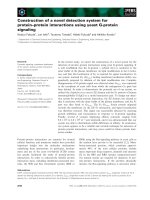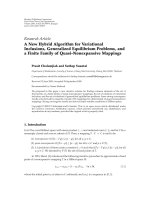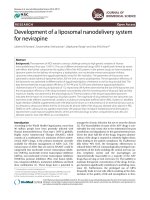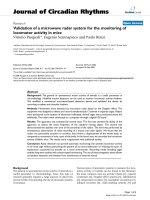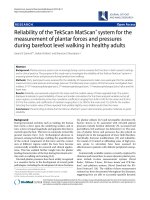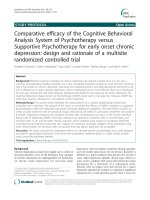Optimal sizing of grid PV hybrid system for ethio telecom access layer devices and its economic feasibility
Bạn đang xem bản rút gọn của tài liệu. Xem và tải ngay bản đầy đủ của tài liệu tại đây (3.01 MB, 99 trang )
Optimal Sizing of Grid-PV Hybrid
System for ethio telecom Access Layer
Devices and Its Economic Feasibility
Rihana Mohammed Nuru
Advisor: Dr. Solomon Abebe
A Thesis Submitted to
The Center of Energy Technology
Presented in Fulfillment of the Requirements for the Degree of Master of Science
(Energy Technology)
Addis Ababa University
Addis Ababa, Ethiopia
June 2017
Addis Ababa University
Addis Ababa Institute of Technology
Center of Energy Technology
This is to certify that the thesis prepared by Rihana Mohammed, entitled: Optimal Sizing of GridPV Hybrid System for ethio telecom Access Layer Devices and Its Economic Feasibility,
submitted in partial fulfillment of the requirements for the degree of Master of Sciences (Energy
Technology) complies with the regulations of the University and meets the accepted standards
with respect to originality and quality.
Signed by the Examining Committee:
Internal Examiner _____________________________Signature
Date
External Examiner ____________________________ Signature
Date
Advisor ________________________________________Signature
Date
Co-Advisor ____________________________________Signature
Date
_______________________________________________
School or Center Chair Person
Optimal Sizing of Grid-PV Hybrid System for ethio telecom Access Layer Devices and Its Economic Feasibility
2017
ABSTRACT
In Ethiopia, conventional grid power is primary source for base stations with backup from diesel
generator and/or battery. Unstable diesel price; huge expenses of fuel and its transportation; and
high carbon emissions are the main problems associated with fuel energy. Mindful of these facts,
countries move to renewable energy sources. The work behind this paper is to determine the
optimal size of grid connected solar power system for powering base stations and compare its
performance with the existing system.
The study included 138 base stations that are found in Addis Ababa. They are categorized in to five
based on their technology – GULC, GUC, GUL, GU and UO. To estimate the size of PV module, real
time power consumption data was collected from ethio-telecom Network Operating Center (NOC)
for a period of about one year (Dec. 01, 2015 to Nov. 30, 2016) - 7,860 records for each site. In
addition, hourly metrological data, specifically global horizontal, diffuse solar radiation,
temperature and wind speed, were collected from National Metrological Agency. The proposed
hybrid model comprises of PV-Grid-Battery. This project employed linear programming as
optimization method and MATLAB program was used to compute hourly DC electric power output
and to solve the developed optimization model.
The finding showed that the highest power consumption was nearly 6KWs in GUC and GULC
technologies, while the lowest was found to be in UO technology – around 1 KW. The number of PV
modules in the hybrid system for UO technology is lower, which shows it can be implemented in all
areas; while the other two technologies, GUL and GU, required green field /outdoor base stations.
In addition the simulation output revealed that the system automatically chose the grid in case
where subsidized/current cost of electricity was considered, while the model builds PV system to
supply its energy need when the real electricity cost was utilized. This implied that PV’s economic
competence was hindered by local policy. Moreover, life cycle cost comparison of PV and DG
showed that photovoltaic systems are more economical than diesel generator systems.
As this evidence has several ramifications, it is better to promote PV to be used in any power design
of BS. Promoting competitive PV market is also important to avail sufficient generation capacity to
cover the local need.
i|P a g e
Optimal Sizing of Grid-PV Hybrid System for ethio telecom Access Layer Devices and Its Economic Feasibility
2017
ACKNOWLEDGEMENT
Primarily my deepest gratitude is extended to the one Almighty God ALLAH, for his infinite
grant throughout my life.
My advisor; Dr. Solomon Abebe (previous head of Energy Center in AAiT) deserve my strong
gratitude for his priceless comments and excellent supervision. My gratefulness is also
forwarded to Dr Abebayehu Aseffa (whom suddenly passed away) granted me to join this
department in the first place.
My appreciation also extends to members of the ethio telecom including: Ato Esubalew, Ato
Tesfaye, W/ro Zelalaem, Ato Abel, Ato Addiss and Ato Tekalign.
My sincere thanks is further offered to my lovely family; My husband Ibrahim Idris, my
daughter Suad, My mom Zehara Mohammed, my sisters Hajira and Mebruka , all my brothers
for their encouragement, appreciation and financial and moral support.
My best friends who had supported me throughout all this thesis work in every aspect deserves
my heartily acknowledgement.
Organizations that I really want to acknowledge for their unlimited support throughout my
thesis work is primarily ethio telecom which gave me permission to gather most of the
necessary information and data throughout most of its branches. Ministry of Metrological
Agency has also helped me in delivering metrological data’s.
Though not possible to exhaustively mention all friends, relatives and each and every
cooperator by name who gave me a hand in some way during this work, I truly would like to say
thanks to all.
ii | P a g e
Optimal Sizing of Grid-PV Hybrid System for ethio telecom Access Layer Devices and Its Economic Feasibility
2017
Contents
ABSTRACT .................................................................................................................................................... i
ACKNOWLEDGEMENT................................................................................................................................. ii
Contents .....................................................................................................................................................iii
List of Acronyms .........................................................................................................................................vi
List of Symbols .............................................................................................................................................x
List of Figures ............................................................................................................................................. xii
List of Tables ............................................................................................................................................. xiii
CHAPTER ONE: INTRODUCTION .................................................................................................................. 1
1.1. Background .......................................................................................................................................... 1
1.2 Problem Definition ................................................................................................................................ 3
1.3 Significance of the study ....................................................................................................................... 5
1.4 Research Question ................................................................................................................................ 5
1.5 objective of the study ........................................................................................................................... 6
General Objective.................................................................................................................................... 6
Specific objectives ................................................................................................................................... 6
1.6 Limitation of the study .......................................................................................................................... 6
CHAPTER TWO: LITERATURE REVIEW ......................................................................................................... 7
2.1 Mobile Telephony Network .................................................................................................................. 7
2.2 Cellular Base Stations (BS) .................................................................................................................... 8
2.2.1 Power Consumption of BS .............................................................................................................. 9
2.2.2 Power Sources for BS .................................................................................................................... 10
2.3 Components Used in Hybrid Model .................................................................................................... 12
2.4 Economic Model Based on Life Cycle Cost (LCC) ................................................................................. 14
2.5 Optimization Method.......................................................................................................................... 18
2.5.1 Linear Programming (LP) ............................................................................................................. 18
2.5.2 Optimization Solver and Algorithm .............................................................................................. 20
2.6 Related Works ..................................................................................................................................... 21
CHAPTER THREE: METHODOLOGY ............................................................................................................ 25
3.1 Description of ethio-telecom (Study Company) .................................................................................. 25
3.2 Study Area........................................................................................................................................... 27
iii | P a g e
Optimal Sizing of Grid-PV Hybrid System for ethio telecom Access Layer Devices and Its Economic Feasibility
2017
3.3 Specification of PV module and Battery .............................................................................................. 28
3.4 Metrological data ................................................................................................................................ 28
3.5 Determination of hourly DC Power Output......................................................................................... 29
3.6 Base Stations (BS) ............................................................................................................................... 30
3.6.1 Factors Affecting Power Requirement of Base Stations ............................................................... 30
3.6.2 BTS Site Selection and Site Background ........................................................................................ 31
3.6.3 Description of BTS Load Profile .................................................................................................... 32
3.7 Model Design ...................................................................................................................................... 32
3.7.1 Proposed Model ........................................................................................................................... 32
3.7.2 Modeling the Proposed Model in Terms of LP .............................................................................. 33
3.7.3 Component Size ............................................................................................................................ 35
3.7.4 PV and DG Life Cycle Cost (LCC) .................................................................................................... 36
3.7.5 Simulation Parameters ................................................................................................................. 36
CHAPTER FOUR: RESULT AND DISCUSSION ............................................................................................... 38
4.1 Simulation of DC Power Generated .................................................................................................... 38
4.2 SPSS Regression Result ....................................................................................................................... 39
4.3 BTS Sites Load Profile Result ............................................................................................................... 39
4.4 Optimization Result ............................................................................................................................ 42
4.4.1 Component Size ............................................................................................................................ 42
4.4.2 Life Time Cost of PV and DG ......................................................................................................... 44
4.5 DISCUSSION ........................................................................................................................................ 45
CHAPTER FIVE: CONCLUSION AND RECOMMENDATION .......................................................................... 50
REFERENCES.............................................................................................................................................. 52
APPENDIX.................................................................................................................................................. 58
Appendix A: Evolution of Mobile Cellular technology ........................................................................... 58
Appendix B: Sequence of Activities in Determining DC Power Output ................................................. 63
Appendix C: MatLab Code for the DC Power Production from a single Module ................................... 68
Appendix D: Expressions for variables .................................................................................................. 71
Appendix E: Simulation out Put for Scenario I ...................................................................................... 72
Appendix F: Simulation Output for Scenario II ...................................................................................... 74
Appendix G: Pseudo Code for System Sizing ......................................................................................... 75
Appendix H: Battery and PV module Datasheet ................................................................................... 76
iv | P a g e
Optimal Sizing of Grid-PV Hybrid System for ethio telecom Access Layer Devices and Its Economic Feasibility
2017
Appendix I: Sample Metrological Data .................................................................................................. 81
v|P a g e
Optimal Sizing of Grid-PV Hybrid System for ethio telecom Access Layer Devices and Its Economic Feasibility
2017
List of Acronyms
0-9
1G
First Generations
2G
Second Generations
3G
Third Generations
3GPP
3rd Generation Partnership Project
4G
Fourth Generations
5G
Fifth Generations
A
AC
Alternating Current
ADSL
Asymmetric Digital Subscriber Line
Ah
Ampere-Hour
AMPS
Advanced Mobile Phone System
B
BS
Base Stations
BSC
Base Station Controller
BSS
Base Station Subsystem
BTS
Base Transceiver Station
C
C
Total Cost
CDMA
Code Division Multiple Access
CI
Capital Costs
COE
Cost Of Energy
COM
Operation and Maintenance Cost
CPE
Customer Premises Equipment
CR
Replacement Costs
D
DC
Direct Current
DG
Diesel Generator
DOD
Depth Of Discharge
E
EDGE
Enhanced Data Rate for GSM Evolution
EEU
Ethiopian Electric Utility
vi | P a g e
Optimal Sizing of Grid-PV Hybrid System for ethio telecom Access Layer Devices and Its Economic Feasibility
EGPRS
Enhanced GPRS
EOT
Equation of Time
ETC
Ethiopian Telecommunications Corporation
EVDO
Evolution Data Optimized
2017
F
FDMA
Frequency Division Multiple Access
G
GMSC
G
Gateway MSC
GPRS
General Packet Radio Service
GSM
Global System for Mobile Communication
GU
GSM and UMTS
GUC
GSM, UMTS and CDMA
GUL
GSM, UMTS and LTE
GULC
GSM ,UMTS ,LTE and CDMA
H
HES
Hybrid Energy System
HOMER
Hybrid Optimization Model Electric Renewable
I
ICT
Information Communication Technology
IMEI
International Mobile Equipment Identity
IMSI
International Mobile Subscriber Identity
IMT
International Mobile Telephone
ISDN
Integrated Service Digital Network
ITU
International Telecommunication Union
K
Kbps
Kilo bit Per Second
KWh
Kilo Watt hour
L
LAC
Levelized Annual Cost
LCC
Life Cycle Cost
LOLP
Loss of Load Probability
LP
Linear Programming
LTE
Long Term Evolution
vii | P a g e
Optimal Sizing of Grid-PV Hybrid System for ethio telecom Access Layer Devices and Its Economic Feasibility
2017
M
MAP
Mobile Application Part
MCIT
Ministry of Communications and Information Technology
MMS
Multi Media Messaging Service
MS
Mobile Station
MSAG
Multi Service Access Gateway
MSAN
Multi Service Access Node
MSC
Mobile Service Switching Center
N
NMT
Nordic Mobile Telephones
NOC
Network Operating Center
NPV
Net Present Value
NSS
Network Switching Subsystem
NTT
Nippon Telegraph And Telephone
O
OFDMA
Orthogonal Frequency Division Multiple Access
P
PIN
Personal Identity Number
PSTN
Public Switched Telephone Network
PUK
Pin Unblocking Key
PV
Photovoltaic
R
RET
Renewable Energy Technologies
RRU
Remote Radio Unit
S
SIM
Subscriber Identity Module
SMS
Short Message Service
SPSS
Statistical Package for Social Sciences
ST
Solar Time
STC
Standard Test Conditions
T
TACS
Total Access Communication Systems
TDMA
Time Division Multiple Access
viii | P a g e
Optimal Sizing of Grid-PV Hybrid System for ethio telecom Access Layer Devices and Its Economic Feasibility
TWh
2017
Tera Watt hours
U
UMTS
Universal Mobile Telecommunication System
UO
UMTS Only
V
V
Volt
VPN
Virtual Private Network
W
W
Watt
WCDMA
Wideband CDMA
WLAN
Wireless Local Area Network
Wp
Watt Peak
ix | P a g e
Optimal Sizing of Grid-PV Hybrid System for ethio telecom Access Layer Devices and Its Economic Feasibility
2017
List of Symbols
Declination Angle
Temperature Coefficient of the Peak Power (W/K0) of the Module
The Diesel Consumption Per Year (Liter)
Diesel Cost Per Liter Taken ($/Liter)
The Cost of Energy Storage Depending on Energy Rating ($/Kwh)
Capital Cost of Storage Unit Depending on Power Rating ($/W)
Capital Cost of Diesel Generator
Capital Cost of Renewable PV ($/Watt)
The NPV of Annual Operation and Maintenance Cost of Battery
The NPV of Annual Operation and Maintenance Cost of DG
The NPV of Annual Operation and Maintenance Cost of PV Module
The NPV of Diesel Generator Service Cost
d
Discount Rate (%)
e
Inflation Rate (%)
The Energy Storage Capacity of the Storage Unit.
Energy From the Grid
The Instantaneous Energy Stored In the Battery
Normalized Output Power Profile of the PV Module Source
Module Irradiance
N
Life Time (Yr)
Life Time of Battery
The No. of Times the Generator is Serviced During the Lifetime of N Years
The Number of Battery Replacements In N Number of Years
DC Power Output of Representative Module
Power rating of the Grid
Instantaneous Powers Delivered By the Grid
Limits on Maximum Rating from the Grid
Instantaneous Load at a Site
Limits on Maximum Rating of the PV Modules
x|P a g e
Optimal Sizing of Grid-PV Hybrid System for ethio telecom Access Layer Devices and Its Economic Feasibility
2017
Power Ratings of the PV Module
Instantaneous Powers Delivered by PV Module
Power Ratings of the Storage Unit
The Maximum Power Rating of the Storage Unit
Instantaneous Powers Delivered By the Storage
r
The Diesel Generator Service Period (Yr)
Module Temperature
Hour Angle
xi | P a g e
Optimal Sizing of Grid-PV Hybrid System for ethio telecom Access Layer Devices and Its Economic Feasibility
2017
List of Figures
Figure 2.1
Structure of Mobile Network…………………………………………………………………………………
7
Figure 2.2
Architecture of the Macro cell, Microcell, and Femto cell base station…………………
9
Figure 2.3
Buildup of a solar PV array from cell to module to panel to final array…………………..
13
Figure 3.1
Indoor position base station camera picture (Sarbet, AA, January 2016)……………….
26
Figure 3.2
Outdoor tower and equipment camera picture (Sarem Building AA, January 2016)
26
Figure 3.3
District Map of Addis Ababa …………………………………………………………………………………..
28
Figure 3.4
Flow Chart to find DC Power Production of a Module……………………………………………
29
Figure 3.5
Proposed model …………………………………………………………………………………………………….
33
Figure 4.1
Generated output dc power at each hour of the year for Addis Ababa City…………..
38
Figure 4.2
Total DC power output from single module for each month for Addis Ababa City….
38
Figure 4.3
Maximum and Real Power Consumption of Technology Type GULC……………………….
40
Figure 4.4
Maximum and Real Power Consumption of Technology Type GUL…………………………
40
Figure 4.5
Maximum and Real Power Consumption of Technology Type GUC………………………..
41
Figure 4.6
Maximum and Real Power Consumption of Technology Type GU…………………………..
41
Figure 4.7
Maximum and Real Power Consumption of Technology Type UO…………………………..
41
Figure 4.8
48 hour Run for Hybrid System (GU)………………………………………………………………………
43
Figure 4.9
Number of PV Module for Subsidized and Real Cost of Electricity…………………………
46
Figure 4.10
Power Generated, required and excess by technology………………………………………….
47
Figure 4.11
LCC Comparison for PV and DG (GUC)……………………………………………………………………
48
Figure 4.12
LCC Comparison for PV and DG (UO)………………………………………………………………………
49
Figure A.1
Figure B.1
Evolution of Mobile Cellular Technology ………………………………………………………………..
Position of the Sun in the sky relative to the solar angles……………………………………….
59
64
Figure B.2
Figure B.3
Relative Position of the sun…………………………………………………………………………………….
Beam Diffuse and ground reflection radiation on a tilted surface…………………………
65
66
Figure E.1
Power contribution for hybrid system (GUC)…………………………………………………………
72
Figure E.2
Power contribution for hybrid system (GUL)………………………………………………………….
72
Figure E.3
Power contribution for hybrid system (GULC)………………………………………………………..
73
Figure E.4
Power contribution for hybrid system (UO)……………………………………………………………
73
Figure E.5
Power contribution for hybrid system (GU)…………………………………………………………….
73
Figure F.1
Power Contribution for Real Cost of Electricity (GU)……………………………………………….
74
Figure F.2
Power Contribution for Subsidized Cost of Electricity (GU)……………………………………..
74
xii | P a g e
Optimal Sizing of Grid-PV Hybrid System for ethio telecom Access Layer Devices and Its Economic Feasibility
2017
List of Tables
Table 2.1
Input, output arguments and their description ……………………………………………
20
Table 3.1
Power Consumption factors description and their Classification …………………
30
Table 3.2
Description of BTS sites, Addis Ababa, Ethiopia, March 2016………………………
31
Table 3.3
Simulation Parameters ………………………………………………………………………………
36
Table 4.1
Regression result for power consumption ……………………………………………………
39
Table 4.2
PV size and LCC for Scenario I ………………………………………………………………………
42
Table 4.3
Effects of Cost of Electricity from the Grid ……………………………………………………
43
Table 4.4
High Solar Scenario ………………………………………………………………………………………
44
Table 4.5
Excess energy produced ………………………………………………………………………………
44
Table 4.6
LCC of PV and Diesel Generator …………………………………………………………………
45
Table 4.7
Energy share of the proposed model ……………………………………………………………
48
xiii | P a g e
Optimal Sizing of Grid-PV Hybrid System for ethio telecom Access Layer Devices and Its Economic Feasibility
2017
CHAPTER ONE: INTRODUCTION
1.1. Background
Telecommunication industry is one of the fastest growing industries in the world. The
unexpected increase in subscribers and demand for telecommunication services led to
tremendous growth in telecommunication networks. Wireless communications, by any
measure, is the fastest growing segment of the communications industry, in particular. Among
the wireless networks, cellular phones have experienced exponential growth over the last
decade, and this growth continues unabated worldwide. In 2014, the number of worldwide
mobile users including both business and consumers will reach over 5.6 billion. By the end of
2018, International Telecommunication Union (ITU) expects the number of worldwide mobile
users to over 6.2 billion. Roughly 84% of the world population will be using mobile technology
by year-end 2018 [1].
Indeed, cellular phones have become a critical business tool and part of everyday life in most
countries, and wireless local area networks are currently poised to supplement or replace wired
networks in many businesses and campuses. Also many new applications, including wireless
sensor networks, automated highways and factories, smart homes and appliances, and remote
telemedicine, are emerging [2].
In Ethiopia, ethio telecom was established in November 2010 by replacing the previous name of
the company Ethiopian Telecommunications Corporation (ETC). The operator has passed
through different names since 1894 E.C at the governance of Emperor Menelik II when the 407
Km telegraph line between the cities of Harar and the capital Addis Ababa was constructed [3].
Currently ethio telecom is the sole service provider of telecom technology in the entire country
with comprehensive plans in place to meet the requirements set out by the Ministry
of Communications and Information Technology (MCIT). The Federal Government of Ethiopia
owned and controlled all telecommunications services, except selling of Customer Premises
Equipment (CPE) [4]. To provide reliable and secured communication services at affordable
price throughout the country, the company has developed extensive mixed-capability
1|P a g e
Optimal Sizing of Grid-PV Hybrid System for ethio telecom Access Layer Devices and Its Economic Feasibility
2017
Information Communication Technology (ICT) infrastructure that provides a blended coverage
of 85% of the country’s population, with the potential to serve 90% of its population. Over 500
cities have been connected to fixed-line Internet and every regional capital municipality has
fiber connectivity [5].
Like most countries, the telecommunication network architecture of ethio telecom has four
layers, namely: service layer, control layer, transport layer and finally access layer. Each layer
has different function and contains various network equipments [2].
Among other services, the company offers fixed line telephone, Fax, Internet, data, mobile
post-paid, mobile roaming, mobile internet, fixed wireless broad band (Aironet), Evolution Data
Optimized (EVDO), fixed broadband Asymmetric Digital Subscriber Line (ADSL), virtual private
network (VPN), videoconference and Tele conferencing [5]. Mobile service in Ethiopia has
existed since 1999 G.C and at that time the network coverage was limited to Addis Ababa with
a network capacity not more than 60,000 subscribers. According to September 18, 2012 press
release, the subscription of mobile reached 17.26 million at the end of 2011 [3].
To provide mobile service, ethio telecom uses Base Transceiver Station (BTS) that help to
connect the service provider with the customer [6, 7]; which is placed in access layer of the
integrated network structure. It is one of Base Station Subsystem (BSS) element that is used to
connect Mobile station (MS) to the network through air interface on one side and Network
Switching Subsystem (NSS) on the other side [6-8].
In providing mobile services throughout the country, two vendors (ZTE and HUAWEI) signed a
contract with ethio telecom; to this end, BTS is installed with the inventory of these two
companies. BTS, depending on people density, could be located in city, regions, villages, hill
stations and remote areas; and are positioned either in Ground bases or Roof-top of towers [5].
Nationally, there are about 4,000 BTS sites in rural and urban areas; of these, above 700 of
them are found in the capital city, Addis Ababa [5].
Ethio telecom holds a variety of telecom devices that needs consistent power source to be
operational. The company got this power mainly from the national grid, and uses this power
2|P a g e
Optimal Sizing of Grid-PV Hybrid System for ethio telecom Access Layer Devices and Its Economic Feasibility
2017
source alone or with generator and/or batteries as backup. In addition for off grid or remote
areas, the company uses commonly generator and battery, but in few places solar power is
available.
1.2 Problem Definition
Developing countries like Ethiopia have serious energy crisis. Satisfying the power demand of
the people for the fundamental necessities by itself is in much a bother situation. Hence,
governments and peoples started looking towards permanent and never-ending sources of
energy called renewable sources of energy such as solar and wind energy. The positive aspect
of use of renewable energy sources in these countries is that they are available in plenty and
also pollution free.
Although, vendors and operators of equipment for mobile communications in developing
countries have been facing difficulty to meet certain challenges such as it costs much, expensive
to run, uses much power and is difficult in deploying with limited electricity supply. For
instance, many people in emerging markets like Ethiopia live in rural areas with limited access
to the electricity grid; it becomes a significant barrier to expanding network coverage in these
areas as mobile phone base stations rely on a secure supply of power. Even in areas connected
to the grid, the power supply can be unstable and disrupt. And also due to the reach of mobile
telephony among the people in remote villages, the service providers are stressed for finding a
working solution to the energy crisis. Thus the provision to power the base stations for mobile
operators with renewable energy is gaining importance steeply.
Like other mobile communication devices, BS devices required power to be operational. In
Addis Ababa, Ethiopia, currently most of the BS gets power from commercial line of Ethiopian
Electric Utility (EEU). In addition, these devices were using generator and/or battery as backup
in situations when power is disrupted. Although, the national power provider EEU has
accelerated its progress in connecting towns and supplying power, electrification rates remain
low and are well known in its frequent interruption. The alternative sources, batteries and
diesel generators, are unsuitable for long hours and expensive to operate, respectively.
3|P a g e
Optimal Sizing of Grid-PV Hybrid System for ethio telecom Access Layer Devices and Its Economic Feasibility
2017
On the other hand, if there is no adequate and continuous power supply for the BTS sites, it is
difficult to ensure service continuity. As a result, all services supported by the respective
devices will automatically be paused. These problems become more challenging in countries
like Ethiopia, where power interruption from the grid is more common and where there is lack
of reliable power supply for remote locations. Moreover, in rural areas energy consumption
contributes most of the total network operating cost. Thus, this expenditure on energy as a
result of the lack of grid availability highlights a potential barrier to the growth of the service
delivered by the company and ensuring reliable services throughout the country.
Fortunately solar power is available in almost every location no matter how remote and can be
used for low- and medium capacity sites. Apart from having very low environmental impact,
solar-powered sites have the advantage of being very low maintenance, with a technical
lifetime of about 35 years or more [9]. In addition it allows deeper penetration of mobile
networks and much more reliable than diesel generator-powered systems. And also it can
scales with the load, so the size of the solar installation can be matched to actual needs without
unnecessary capacity. However the fact that solar photovoltaic (PV) technology is not yet
commercially mature in developing countries [10].
Generally, using photovoltaic energy sources to power the sites has the potential to resolve the
three key needs of the company, namely: reduction in diesel usage; expansion of telecom
infrastructure to off-grid areas; and reduction in carbon emissions.
Despite Ethiopia receives abundant sunshine for around 365 days a year with a solar irradiation
of 5000 – 7000 Wh/m² according to region and season, Ethiopia did not utilize the resource
properly. Seasonally the radiation intensity in the country ranged from highest (5.55-6.25
kWh/m2/day) for areas around northern Ethiopia to lowest (4.25-4.55 kWh/m2/day) for the
extreme western lowlands [11]. Amazingly, a total of 2.199 million Tera Watt hours (TWh) solar
energy can be reserved annually in this country [12].
Thus, the possibility of using such renewable energy technology, solar photovoltaic, might be an
option for Ethiopia, as the country is gifted with huge solar radiation. Aware of the
aforementioned facts, this project investigates the techno-economic feasibility of solar system.
4|P a g e
Optimal Sizing of Grid-PV Hybrid System for ethio telecom Access Layer Devices and Its Economic Feasibility
2017
It presents real data obtained from an operational site and elaborates on how such a system
could allow better energy management, reduce emissions and move towards sustainable
energy. The proposed system is intended to ensure the service continuity through designing a
photovoltaic system as alternative power source for base stations in ethio telecom; this
includes assessing site type, site connectivity to the fixed network, site configuration, the power
consumption of the site, site position, design of optimum PV sizing and evaluating its economic
feasibility.
1.3 Significance of the study
The significance of this stydy is to ensure service continuity and reduce dependency on
commercial line of Ethiopian Electric Utility (EEU) through an optimal sizing of Grid-PV hybrid
system. In addition, the project shows that availability of alternative PV power source for
telecom access layer devices and to minimize the power cost. Furthermore, this project
encourages further studies that can be done to utilize available alternative power sources for
other network equipments. Finally, the findings of this study will serve as a reference for other
studies and decision makers for planning.
1.4 Research Question
This study is intended to answer the following Questions:
What amount of power is consumed by base stations that are found in Addis Ababa?
What are the gaps in the existing power system of the base stations?
What alternative power source do we have for the base stations?
What will be the optimum size of the alternative power source?
Is the alternative power source economically feasible?
5|P a g e
Optimal Sizing of Grid-PV Hybrid System for ethio telecom Access Layer Devices and Its Economic Feasibility
2017
1.5 objective of the study
General Objective
The main objective of this stydy is to model and develop alternative power source for ethio
telecom access layer devices, BTS towers, using Grid connected PV system and size the system
using proper optimization method.
Specific objectives
The specific objectives to be undertaken to reach at the general objectives are to:
Assess the solar radiation of Addis Ababa
Determine the DC power output of a single module at Addis Ababa
Assess type, position and configuration of BTS sites and determine the load pattern of
the BTS sites by each category
Develop a model and formulate objective function and constraints
Determine optimum sizing which can fit the required power using appropriate
optimization method
Determine the economic feasibility of the proposed system
1.6 Limitation of the study
The fact that the study was done only in Addis Ababa, it may limit its generalization of
using the alternative power source nationally;
6|P a g e
Optimal Sizing of Grid-PV Hybrid System for ethio telecom Access Layer Devices and Its Economic Feasibility
2017
CHAPTER TWO: LITERATURE REVIEW
2.1 Mobile Telephony Network
Consumers seek communication at home or in the street, always using the mobile phone
beyond the limitations imposed by cables. However, in order to be able to use a mobile phone
at least one telephone wireless network is required. (More detail on mobile technology,
definition of technical terms, and mobile evolution is given in Appendix A). The network shown
in Figure 2.1 required different network devices to get the desired communication [13].
Figure 2.1 Structure of Mobile Network, [13]
A mobile telephony network is generally composed of the following:
Mobile station (MS): The MS includes all user equipment and software needed for
communication with network. It consists of the subscriber identity module (SIM), which is a
data base on the user side that stores all user-specific data [8, 14]. It contains many identifiers
and tables, such as card-type, serial number, a list of subscribed services, a personal identity
number (PIN), a PIN unblocking key (PUK), an authentication key Ki, and the international
mobile subscriber identity (IMSI). And MS can be identified via the international mobile
equipment identity (IMEI), a user can personalize any MS using his or her SIM, i.e., user-specific
mechanisms like charging and authentication are based on the SIM, not on the device itself [8].
7|P a g e
Optimal Sizing of Grid-PV Hybrid System for ethio telecom Access Layer Devices and Its Economic Feasibility
2017
Base transceiver station (BTS): A BTS comprises all radio equipment, i.e., antennas, signal
processing, amplifiers necessary for radio transmission. Also it provides the physical connection
of MS to the network through Air-interface. On the other side, it is connected to the Base
Station Controller (BSC) via the Abis-interface [8].
Base station controller (BSC): is a small digital exchange its function is to switch the incoming
traffic channels through A-interface from the Mobile service Switching Center (MSC) to the
correct Abis-interface channels. In addition it manages BTS’s, reserves radio frequencies,
handles the handover from one BTS to another within the Base Station Subsystem (BSS) and
performs paging of the MS [8, 14].
Mobile services switching center (MSC): MSCs are high-performance digital integrated service
digital network (ISDN) switches. They set up connections to other MSCs and to the BSCs via the
A-interface, and form the fixed backbone network of a system. Typically, an MSC manages
several BSCs in a geographical region. It also handles all signaling needed for connection setup,
connection release and handover of connections to other MSCs [8].
Gateway MSC (GMSC) has additional connections to other fixed networks, such as public
switched Telephone network (PSTN) and ISDN [8].
2.2 Cellular Base Stations (BS)
A base station is a wireless system situated at the heart of the cell (The area covered by base
station signals); it includes an antenna, a controller and a number of transmitters and receivers.
Usually, three antennas with hundred and twenty degrees are mounted on the top of the
metallic tower to cover the specified region and connected to Remote Radio Unit (RRU) with
cables. Though these antennas are operated at different frequencies they are well separated
from each other to avoid interference of emitted power from each other [15, 16].
Also at the bottom of the tower a small house of electronic circuits often called a shelter is
found, contained power amplifiers that are used to generate strong signals and they are
connected to RRU with fiber. The base station also has additional components within a shelter
include digital signal processing unit, microwave link, rectifier, air conditioning elements (for
8|P a g e
Optimal Sizing of Grid-PV Hybrid System for ethio telecom Access Layer Devices and Its Economic Feasibility
2017
indoor base station) and lighting. Also many base stations have a Direct Current (DC) power
back up system in the form of batteries connected either in series or parallel [16].
2.2.1 Power Consumption of BS
Base stations can be classified as Macro cell, Micro cell, and Small cell (Pico and Femto) base
station based on the amount of area covered. Small cells cover the smallest area and they are
deployed in a room, offices or shopping malls, metro stations etc. Micro cells can cover blocks
of buildings in densely populated urban locality and cover area more than Small cells. Macro
cells cover the largest area among all the cells and generally they are deployed in rural areas or
on high ways. The number and type of components for each type of BS are different as shown
in Figure 2.2 below [17].
Figure 2.2 Architecture of the Macro cell, Microcell, and Femto cell base station, [18]
The base station’s power consumption can be determined by the sum of the power
consumption of all those components. However, as shown in Figure 2.2, some of the
components are used multiple times depending on the configuration of the base station. The
power consumption of these components should thus be multiplied by their number of
occurrences. The type and the number of the required components depend on two factors: the
9|P a g e
Optimal Sizing of Grid-PV Hybrid System for ethio telecom Access Layer Devices and Its Economic Feasibility
2017
number of sectors and the number of transmitting antennas. The term sector represents subarea in a given cell, which is an area covered by base station [17, 18].
Each sector is covered by one antenna and needs therefore one rectifier, one digital signal
processor, one transceiver, and one power amplifier. Therefore the power consumption of
these components must thus be multiplied by number of sector. In addition multiple
transmitting antennas are used per sector, for each transmitting antenna, one transceiver and
one power amplifier are needed. This means that the power consumption of these two
components must not only be multiplied by number of sectors but also by the number of
transmitting antennas [17, 18].
Each of the base station’s components has a typical power consumption value. The power
consumption of the backhaul connection and the rectifier(s) is assumed to be constant
throughout time. The power consumption of the air conditioning is not influenced by the time
but rather by the temperature inside and outside the base station cabin [17, 18].
The power consumption of the digital signal processing, the transceiver, and the power
amplifier can fluctuate during time due to variations in load on the base station. The load
represents the number of active users or the number of calls at that time and the requirements
of the services they use in the base station cell, the higher the load, the higher the base
station’s power consumption *17+.
2.2.2 Power Sources for BS
BS primarily powered by electrical power from the grid in urban areas with a back-up by battery
and/or a diesel generator. The grid power must be available for 24 hours a day to give reliable
service for the customers. But electrical grids are not available or are unreliable in most
locations of developing countries; therefore cellular network operators rely on diesel powered
generators to run a base station.
The idea of using diesel generators as a primary or back-up power supply has become less
favorable due to the challenges linked to their reliability, high operational and maintenance
costs, and their considerable environmental impacts [19]. Therefore adding several base10 | P a g e
